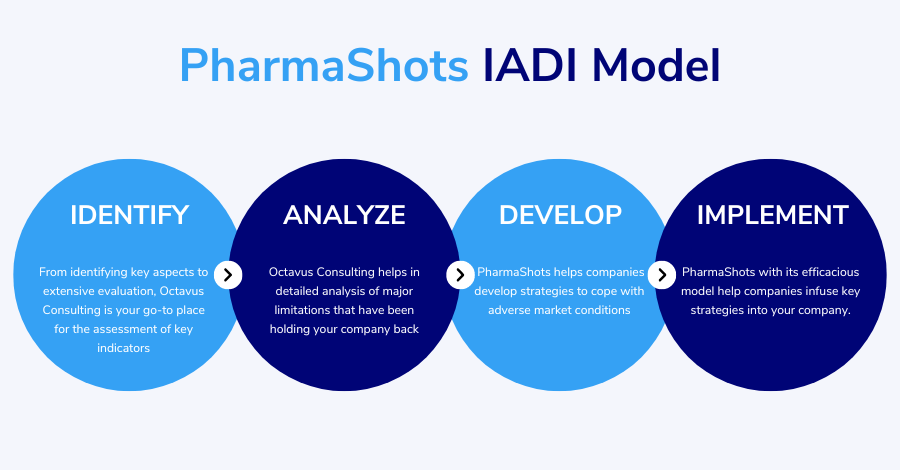
6 Key Factors Influencing the Pharmaceutical Industry
Shots:
- With several swaying factors exerting a direct or indirect impact on the overall functioning of the pharmaceutical industry, understanding the nitty-gritty of the operational model of the industry can be clumsy
-
PharmaShots presents an intuitive article on 6 key factors that exercise control over the pharmaceutical industry
-
To counter such challenges, we have devised an IADI model that encompasses the nuances and intricacies of such challenges with the help of our parent company Octavus Consulting. Sit back and relax, while the article unfolds before you, the magic model that is certain to revamp your company
Achieving economic sustenance and ensuring smooth sailing even in unfavorable situations are two common dreams that every pharmaceutical company shares. To integrate these significant aspects into the present industry models, industries must identify their limitations and devise strategic plans to mitigate the fallible conditions. The pharmaceutical industry is no exception when it comes to challenges. Several aspects, like social, regulatory, economic, technological, and environmental affect the pharmaceutical industry. Nerve centers of giant companies assess the future possibilities and challenges that may befall the company and try to overcome them with a well-structured roadmap. Even though it is impossible to block future adverse scenarios completely, companies can recalibrate strategies to get well-prepared for such instances beforehand. Assessment of such factors holds a degree of paramount importance, as such factors define the overall requirement in a particular geography or a country. The article briefly elaborates on the six major factors that every pharma company should assess to scale up and ace the market and introduces an efficacious model to keep frequent checks on the factors. Sit back and relax, while PharmaShots unfolds the six factors that influence the pharmaceutical industry.
Social Factors
-
Generation Health: This aspect is crucial as it corresponds to the layouts of drug development requirements based on the patient population of geography. Compared to the younger generation, the geriatric population requires more drugs. With demography groups attributing to the considerable number of sales, it becomes essential for pharmaceutical companies to develop personalized medicines to meet the unmet demands.
-
Prevalence of Obesity: Obesity acts as an instigator for other health-related conditions like diabetes, cardiovascular, hypertension, and many more. Due to a surge in such conditions, companies must manufacture drugs related to such conditions.
-
Health Consciousness: With an acute inclination towards a healthy lifestyle, people nowadays tend to exercise more and indulge in fitness activities. Moreover, dietary awareness amongst the general public has spiked owing to IoTs, indirectly influencing the sales of vitamin supplements.
Regulatory Factors
A few key factors create dramatic upshots in the pharmaceutical sector. Some of the major aspects are:
-
Government Framework: While certain countries follow a liberal approach towards pharma companies, most frameworks push startups towards generic drug development. Such frameworks inhibit companies from developing new drugs due to the lack of innovations and the risks involved.
-
Price Control: In the US, the pharmaceutical industry has the liberty to regulate drug prices, whereas, in the EU, the government regulates the prices by dealing directly with pharmaceutical companies. Moreover, different entities like insurance companies and pharmacies indirectly influence the price of a drug.
-
New Drugs: With unceasing R&D, new drugs always hit the market now and then. The arrival of a new drug impacts the competitive environment for the existing companies, affecting sales, market reach, procurement and supply chain management, and many other crucial aspects.
Technological Factors
Innovations and technological advances expedite the overall growth of the pharmaceutical industry. Several other aspects attribute to the pharmaceutical sector, such as
-
Growth in the Biotech Industry: Biotech industry directly influences the progress of the pharma sector. When it comes to introducing trending vaccines and medications, the biotech industry has always served as a frontier manufacturer for any condition.
-
Market Reach: Pharma companies often struggle to sustain themselves in the market as similar products compete closely to gain dominance. Companies that leverage thorough market research succeed in making a place in the market.
-
Rigid Legislation: To ensure consumers' health, green practices, and overall safety, the pharmaceutical industry is impelled to comply with rigorous legislative guidelines.
-
Corporate Espionage & Cyber Security: The classic incident of corporate espionage was witnessed in 1997 when two defendants pleaded guilty to stealing a plant cell culture technology, a product of BMS. With the massive reliability of technology for data management, cyber-attacks combined with espionage have taken a vicious form. To mitigate the potential risks of cyber-attacks, companies are gradually transitioning to blockchain technology to safeguard their data.
Environmental Factors
Pharmaceutical companies are compliant to adopt a green approach towards manufacturing. With countries unanimously drafting plans to control carbon emissions and ensure good manufacturing practices, the docile pharma industry has no other options than to enact safe manufacturing processes. Companies are obligated to enact these two parameters:
-
Minimal Carbon Footprint: To minimize the carbon footprint, companies make sure that (CO2) emission at the time of manufacturing is by the set standard.
-
Free from Contamination: Pharmaceutical companies, right from the early drug discovery stage create an aseptic environment to ensure that every stage, ranging from discovery to approval, is carried out in the absence of any unsought pollutant that may damage the integrity of the drug.
Procurement & Supply Chain Management
One of the major factors in the pharmaceutical industry is ensuring a continuous supply of resources and end products to meet market demand. With contract manufacturing organizations (CMOs) and contract development & manufacturing organizations (CDMOs), big pharmaceutical companies often outsource manufacturing to cut costs by abstaining from in-house manufacturing.
Geopolitical Factors
In the pharmaceutical industry, there are a few challenges, like geopolitical conflicts, that cannot be assessed beforehand. Amidst Russia Ukraine war, the pharmaceutical industry suffered a major setback. This inadvertent factor impacted the pharmaceutical industry negatively leading to a considerable loss of revenue as Ukraine ranked 61st among pharmaceutical product exporters. Owing to the tension in the South China Sea between Taiwan and the People's Republic of China, such instances are more likely to be seen. In such cases, drafting a backup plan is a major challenge for the pharmaceutical industry.
Overcoming Challenges
So far, we have encompassed major existing as well as near-future challenges for the pharmaceutical sector. A holistic approach to handling such scenarios is entirely subjective, as the one-size-fits-all model does not work for every pharmaceutical company. Devising a single roadmap to overcome the challenges is beyond the scope of this article. PharmaShots has closely studied the operations and challenges of the pharmaceutical industry and developed a straightforward IADI model to help companies overcome the challenges.
The model unfolds with four power verbs, Identify, Analyze, Develop, and Implement. Let us discuss each aspect in brief to get an overview of the model.

-
Identify: From the assessment of finances to human resources and beyond, the evaluation of key performance indicators (KPIs) plays a crucial role in identifying the significant aspects and focus areas of a company. When we deal with the pharmaceutical industry, which is a staggering tower of multiple departments, the identification of KPIs can be overwhelming. The first step to integrating the model into the industry is identifying the KPIs.
-
Analyze: Post identification comes to the analysis of several other aspects such as market analysis, ethnographic research, and most importantly a detailed study on competitive intelligence. For such extensive research work, often, companies hire market analysts to maintain a constant influx of high-end market intelligence.
-
Develop: Creating a strategic roadmap requires an intricate understanding of the framework development and a comprehensive knowledge of integrating real-time business intelligence into the current model to gain maximum profit. A minimal error in drafting a framework can accelerate long-chain jeopardizing consequences that may affect the overall growth of the company.
-
Implement: The final call to action in the IADI model is implementation. Now, this is the most crucial step of the model as many major companies have drastically failed when it came to its proper execution. Implementation is a multimodal step that requires multiple checks to ensure proper enforcement of the model.
Conclusions and Perspectives
In hindsight, challenges are a part of every single industry. To be well-prepared in advance, companies need a better understanding of the market, society, and regulatory landscapes, and most importantly, companies should always be ready to embrace new technology whenever required. To aid companies, PharmaShots and its parent company Octavus Consulting, work extensively in catering to the needs of life science companies with several curated models designed especially for the growth of the life science industry. While Octavus helps companies in identifying and analyzing major limitations that have been fettering the overall growth of the companies, PharmaShots on the other hand helps in integrating proven and efficacious models into various departments to ensure long-term growth.
References
Related Post: 8 Major Reasons Behind the Soaring Layoffs in the Pharmaceutical Industry
Tags

Saurabh is a Senior Content Writer at PharmaShots. He is a voracious reader and follows the recent trends and innovations of life science companies diligently. His work at PharmaShots involves writing articles, editing content, and proofreading drafts. He has a knack for writing content that covers the Biotech, MedTech, Pharmaceutical, and Healthcare sectors.




